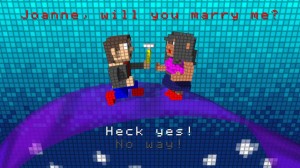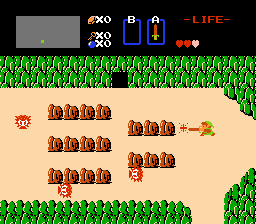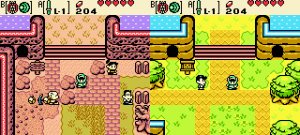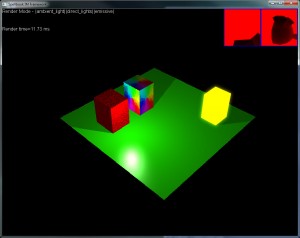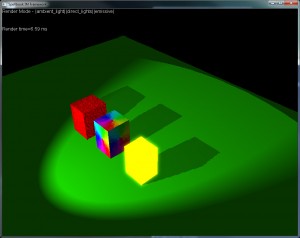Haven’t updated this with news on what I’m doing for a while…
Well, my life is a bit boring at the moment, working on some projects for my day job… the rest of my time I’ve been working on my deferred renderer for my yet-secret project…
First up, I’ve added a decal system, which looks pretty sweet… With it, I intend to add some variety to the game areas:
This works by extracting the geometry affected by the decal (using a clipping algorithm against the decal bounding box). Then this geometry is drawn onto the G-Buffer, which means that the decal is correctly affected by the lighting of the scene. Since there are too many permutations of the shaders used to affect the G-Buffer, I’ve built a small tool that auto-generates the shaders, according to what you want to modulate, etc.
In the examples above:
- Overriding just the color component of the G-Buffer
- Overriding the color and normal component
- Overriding the color and normal, and halving the specular power/gloss components
- Overriding the color and normal, and nullifying the specular power/gloss components
This has the drawback that this kind of decals don’t affect alpha objects, which is a separate pass. The rationale behind it is that there are other techniques that can be used in those particular cases, and lighting of the alpha objects is done through a multipass lighting system.
Second, I added the alpha object rendering system:
The renderer uses the standard multipass renderer I’ve had in Spellbook in the past. This pass is also used if we want to use different kinds of lighting models besides the standard Phong one. This is a completely separate pass, which doesn’t affect the G-Buffer (and hence doesn’t write to the depth buffer render target, only to the standard Z-Buffer). Alpha objects are rendered back to front, and can’t have emissive component (that can be simulated with pre-multiplied alpha).
Finally, I just added a Depth-of-Field effect:
On this video, the most visible effect is changing the focal distance. The effect is done by rendering a blurred version of the rendered scene and by lerping between the blurred and not-blurred version, based on depth (or more precisely, the difference between the depth and the focal distance, considering the focal range).
Next step on this renderer is the screen space distortions, to use with explosions and stuff, which is simple to execute but hard to control from an artistic standpoint.
Besides all this techy stuff (which is really fun for me!), I’ve been playing stuff (as usual):
Trying to get the “Loremaster” achievement done before Cataclysm comes out. It’s fun revisiting some of the early areas, and seeing some of the lore I missed on vanilla WoW… Drawback is wondering all the time “how did I loose so much time playing this, these areas are awful!”.
Finished this one… I was pleasently surprised by it… I was never a huge fan of Transformers (even when I was young… I’d watch it and think it’s cool, but it didn’t have that big of an impact on me as most of the nerds I know!). But it is a very competent shooter, with a nice enough storyline (just wish they added some more of “lore” onto it, like who are exactly the Primes, and what’s the story behind Optimus, since the game for a time hints at a revelation that never comes). The neat part of the game is that it’s actually fluid switching from “vehicle” mode to “giant robot” mode, with advantages in both and different types of fun (specially the flying ones). I’m giving it a 8/10.
I was really looking forward for this one, having loved the first one… and while the game itself didn’t let me down (this is exactly what fighting with the Force should feel like!), the story is one of the worse I’ve seen in the last years… paper-thin, just an excuse to move from stages to stages (kind of reminds me of the terrible narrative of “Heavenly Sword”) killing stuff… but while “Heavenly Sword” was boring and predictable (from a gameplay standpoint), FU2 is fun and engaging.
Really, if the story wasn’t so terrible, it would be one of the best games ever… but the story as it is detracts from the fun… it goes against Star Wars lore, the endings are silly (both the light side and dark side one) and the characters are as badly characterized as it is possible (well, that part is on par with the “Star Wars” movies, to be honest).
The graphics and sound are top notch (the graphics really impressed me, sometimes they deserved the name “photorealistic”), although some areas were too empty to be credible (missing clutter and “function”). And the gameplay is amazing… it’s extremely fluid going from “lightsaber fight” mode to “force-using” mode, which makes for some very neat fights, very dynamic in their approach.
This game could easily have ranked a 10/10, but since the story is so miserable, I’ll give it a 9/10. And I feel sorry for that, since the first one had a story that really compelled you and mashed well with the Star Wars lore…
And that’s it for today… Hopefully, in this week I’ll have the third installment of “Games of my Life” and the second one of “IGF2011 games”…








